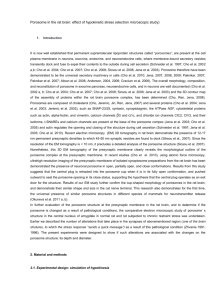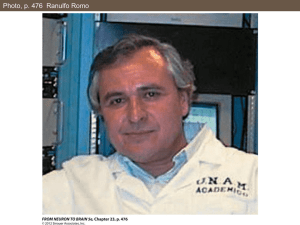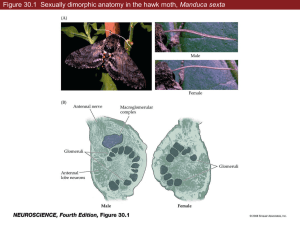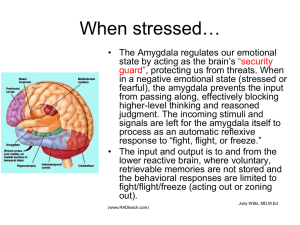Electron Microscopic Morphometry of Isolated Rat Brain Porosome
advertisement
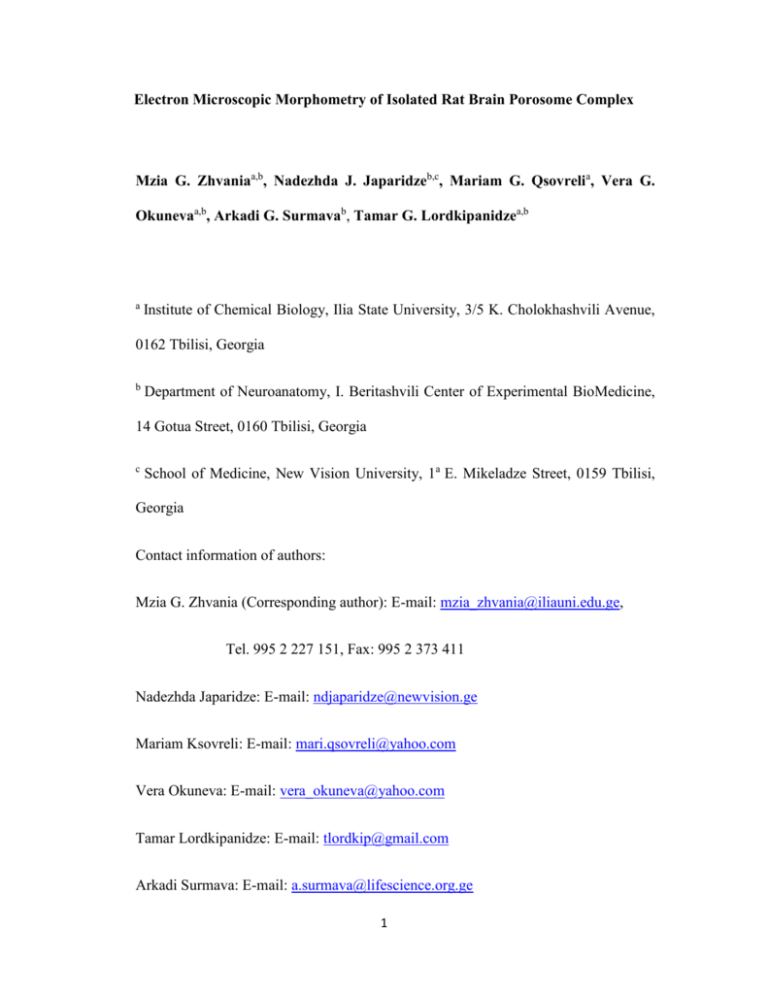
Electron Microscopic Morphometry of Isolated Rat Brain Porosome Complex Mzia G. Zhvaniaa,b, Nadezhda J. Japaridzeb,c, Mariam G. Qsovrelia, Vera G. Okunevaa,b, Arkadi G. Surmavab, Tamar G. Lordkipanidzea,b a Institute of Chemical Biology, Ilia State University, 3/5 K. Cholokhashvili Avenue, 0162 Tbilisi, Georgia b Department of Neuroanatomy, I. Beritashvili Center of Experimental BioMedicine, 14 Gotua Street, 0160 Tbilisi, Georgia c School of Medicine, New Vision University, 1a E. Mikeladze Street, 0159 Tbilisi, Georgia Contact information of authors: Mzia G. Zhvania (Corresponding author): E-mail: mzia_zhvania@iliauni.edu.ge, Tel. 995 2 227 151, Fax: 995 2 373 411 Nadezhda Japaridze: E-mail: ndjaparidze@newvision.ge Mariam Ksovreli: E-mail: mari.qsovreli@yahoo.com Vera Okuneva: E-mail: vera_okuneva@yahoo.com Tamar Lordkipanidze: E-mail: tlordkip@gmail.com Arkadi Surmava: E-mail: a.surmava@lifescience.org.ge 1 Abstract: Porosomes are the universal secretory portals at the cell plasma membrane where membrane-bound secretory vesicles dock and transiently fuse via the kiss-and-run mechanism of cellular secretion, to release intravesicular cargo to the outside of the cell. Through this porosome-mediated mechanism of cell secretion, the accumulation of partially empty secretory vesicles in cells following a secretory episode, and the existence of neurotransmitter transporters at the synaptic vesicle membrane for rapid filling following neurotransmission, is explained. In the past decade a great volume of work from different laboratories provide molecular insights on the structure, function, and composition of the porosome complex, especially the neuronal porosome. In rat neurons 12-17 nm cup-shaped lipoprotein porosomes, possessing a central plug are present at the presynaptic membrane sometimes with docked synaptic vesicles. Although earlier studies have greatly progressed our understanding of the morphology and the proteome and limited lipidome of the neuronal porosome complex, the current study was carried out to determine the morphology of the bare protein backbone of the neuronal porosome complex. Results from our study demonstrate that although the eight-fold symmetry of the immunoisolated porosome is maintained, and the central plug is preserved in the isolated structures, there is a loss in the average size of the porosome complex, possibly due to a loss of lipids from the complex. Key Words: Synaptosome. Immunoisolated neuronal porosome. Ultrastructure. Morphometric analysis. Rat. 2 Introduction In all cells, cellular cargo destined for secretion are packaged and stored within membranous vesicles that transiently dock and establish continuity at the base of cupshaped plasma membrane structures called ‘porosomes’ (Cho et al. 2002 a,b,c; Cho et al. 2004; Cracium et al. 2004) and neurons are no exception (Schneider et al. 1997; Jena et al, 2003; Jeremic et a. 2003; Cho et al. 2007; Siksou et al. 2007; Cho et al. 2008; Cho et al. 2009; Lee et a. 2009; Cho et al. 2010; Zhao et al. 2010; Cho et al. 2011; Drescher et al. 2011; Elshenawy et al. 2011; Okuneva et al. 2012). The ‘porosome’ therefore has been called the universal secretory machinery at the plasma membrane in cells where secretory vesicles transiently dock and fuse to release intravesicular contents to the outside during secretion. It is reported that different cells have different speed of release, which is reflected on both the size of the secretory vesicle and the porosome. Small secretory vesicles fuse faster since they have higher curvature and the membrane is under high surface tension. Hence neurons have small 30-80 nm synaptic vesicles with 12-17 nm porosomes for fast fusion and release in contrast to the 1,200 nm secretory vesicles and the 100-180 nm porosome in the slow-secreting exocrine pancreas (Schneider et al. 1997; Jena et al. 2003; Jeremic et al. 2003). In neurons and astrocytes, representing fast secretory cells, porosomes range in size from 10 to 17 nm. In an earlier study, using atomic force microscopy (AFM) and electron microscope (EM), it was demonstrated that in the neurons 40-50 nm synaptic vesicles are docked at roughly 10 nm in diameter neuronal porosomes (Cho et al. 2004). Recent EM 3D tomography in rat brain also reveals the presence of 12-17 nm permanent presynaptic densities to which 35-50 nm synaptic vesicles are found docked (Siksou et al. 2007). Moreover, the inside-out 3 ultrahigh–resolution AFM study of presynaptic membrane preparations of isolated synaptosomes clearly displays the presence of the inverted cup-shaped 10-17 nm neuronal porosomes. Results from more recent studies using AFM, EM, electron density and 3D contour mapping, provided additional nanoscale information on the structure and assembly of proteins within the neuronal porosome complex (Cho et al. 2008). Particularly, it has become clear that neuronal porosomes possesses a central plug that is absent in porosomes in other kinds of secretory cells. This central plug interacts with proteins at the periphery of the structure, conforming to its 8-fold symmetry; each one of them is connected with spoke-like elements to the central plug that is involved in the rapid opening and closing of the neuronal porosome to the outside (Cho et al. 2009). The neuronal central plug has been further examined at various conformational states, providing its gate-keeping role in neurotransmitter release during neurotransmission. Thus, the central plug at various conformational states: fully retracted, halfway retracted, and completely pushed into the porosome cup, have been elegantly demonstrated (Cho et al. 2010). Although it is easy to observe porosomes in intact synaptosomes and in insideout synaptosome preparations using the AFM, in fixed cells it becomes difficult, since artifacts due to fixation, dehydration and tissue processing for EM, and compounded by the fact that the presynaptic membrane contain a high density of plasma membrane proteins resulting in heavy metal staining, rendering it difficult to observe porosomes from among the other structures. Nonetheless, porosomes are clearly identifiable in electron micrographs in numerous reported studies (Cho et al. 2004;Cho et al. 2007; Cho et al. 2008; Cho et al. 2009; Drescher et al. 2011; Siksou et al. 2007; Lee et al. 2009; Okuneva et al. 2012). To further understand the structure of the neuronal porosome 4 complex, and the bare protein backbone of the complex for future single-particle cryoEM studies, the current study was carried out on immunoisolated porosome complexes from high-detergent solubilized synaptosome membrane preparations. Material and Methods Synaptosome preparation: Synaptosomes were prepared from rat brains according to earlier published methods (Cho et al. 2004). Sprague-Dawley rats weighing 120-150 g were euthanized using preapproved animal use protocol. The entire rat brain is isolated and placed in ice-cold buffered sucrose solution containing 5 mM Hepes, pH 7.4, 0.32 M sucrose, supplemented with protease inhibitor cocktail obtained from Sigma-Aldrich, St. Louis, MO. The brain tissue is then sliced and homogenized using a Teflon-glass homogenizer. The homogenate obtained is subjected to centrifugation for 3 min at 2,500 x g, and the resulting supernatant fraction is again centrifuged for 15 min at 14,500 x g to obtain a pellet. The pellet is then re-suspended in buffered sucrose solution, and layered onto a 3-10-23% Percoll gradient, centrifuged at 28,000 x g for 6 min, and the enriched synaptosome fraction at the 10-23% Percoll gradient interface is collected for the study. Immunoisolation of the neuronal porosome complex: The neuronal porosome complex was immunoisolated using SNAP-25-specific antibody conjugated to protein Asepharose. Synaptosomes isolated from rat brain tissue were used for immunoisolation of the neuronal porosome complexes. For each immunoisolation of the neuronal porosome complex, 5 mg of a 2% Triton-Lubrol-solubilized synaptosome preparation was used. 5 The Triton-Lubrol solubilization buffer contained 1% Triton and 1% Lubrol; 1 mM benzamidine; 5 mM Mg-ATP; and 5 mM EDTA in PBS at pH 7.5. Ten micrograms of SNAP-25 antibody conjugated to the protein A-sepharose was incubated with approximately 5 mg of the solubilized synaptosomes for 1 h at room temperature followed by five washes of 10 vol/wash, using the wash buffer (500 mM NaCl, 10 mM Tris, 2 mM EDTA, pH 7.5). The immunoisolated sample attached to the immunosepharose beads was eluted using a pH 3.0 buffer to obtain the neuronal porosome complex for EM analysis. Transmission electron microscopy: To perform transmission electron microscopy, the isolated neuronal porosomes were fixed in 0.1% paraformaldehyde and 0.1% glutaraldehyde in Hepes-buffered saline (pH 7.2) and stored at 4oC. Formvar and carbon coated copper grids used were first treated with 1% alcian blue for 10 minutes at room temperature, followed by four brief rinses in distilled water and air drying. Approximately of sample solution were then deposited onto the grid surface, followed by two rinses with 0.1 M cacodylate buffer and two rinses in distilled water. The grids were then placed on drops of 2% aqueous uranyl acetate for one min, followed by gentle removable of the staining solution from the grid using a filter paper, and finally air-dried. The air-dried sample was then imaged using a transmission electron microscope and images acquired were stored for later analysis. The distribution of porosome sizes and calculation of mean value was performed using a conventional descriptive statistical method. Results and Discussion 6 On electron micrographs the eight-fold symmetry of the immunoisolated porosome complex was clearly preserved (Figure 1 A). The central plug in the isolated porosome was also well expressed in most intact porosome complexes (Figure 1 B, C). Therefore, immunoisolated neuronal porosomes possesses all the structural characteristics previously reported (Cho et al. 2004, 2007, 2008; Kovari et al. 2014). Interestingly however, the measurements of the diameter of isolated neuronal porosome complexes demonstrate a mean size of 8.21±2.0 nm, with size distribution ranging from 5 to 14 nm (Figure I d, Table 1). This size is a bit smaller than those reported in earlier studies (Cho et al. 2004, 2007, 2008; Kovari et al. 2014), which may possibly be due to a loss of lipida from the isolated complex resulting from our use of 2% detergent to solubilize the synaptosome as opposed to a 1% use of detergents. In the earlier study, to preserve the tightly associated lipids with the neuronal porosome complex, the synaptosome was solubilized using only 1% detergent (Triton-Lubrol). In the current study, to determine the morphology of the bare protein backbone of the neuronal porosome complex, twice as much detergent was used to obtain solubilized synaptosomes for immunoisolation of the porosome complex. It is remarkable that earlier, in rat brain in situ, the dot plot of porosome complex size distribution ranged from 7 to 19 nm, and the dot plot of synaptic vesicle size ranged from 49 to 80 nm was described (Cho et al 2004). The same parameters of porosome complex we detected investigating the brain of different mammals (rat, cat, and dog) (Figure 2 B) (Okuneva et al. 2012). Various pathological conditions, specifically, hypokinetic stress and white noise have previously been demonstrated to have no significant effect on the structure of porosome complex 7 (Japaridze et al. 2012; Zhvania et al. 2014). Importantly however in the current study, although we observe a loss in the average size of the immunoisolated neuronal porosome complex, the eight-fold symmetry and central plug are retained in the structure, demonstrating the structure to be intact. Further, proteomics and lipidomics on the isolated will reveal the possible loss of both lipids and or proteins from the structure under the isolation conditions used in our present study. Porosomes are the universal secretory portals at the cell plasma membrane where membrane-bound secretory vesicles dock and transiently fuse via the kiss-and-run mechanism of cellular secretion, to release intravesicular cargo to the outside of the cell. Through this porosome-mediated mechanism of cell secretion, the accumulation of partially empty secretory vesicles in cells following a secretory episode, and the existence of neurotransmitter transporters at the synaptic vesicle membrane for rapid filling following neurotransmission, can be explained. In the past decade a great volume of work from different laboratories provide molecular insights on the structure, function, and composition of the porosome complex, especially the neuronal porosome complex has been elaborated (Cho et al. 2004, 2007, 2008; Okuneva et al. 2012; Japaridze et al. 2012; Zhvania et al. 2014; Kovari et al. 2014). In rat neurons 12-17 nm cup-shaped lipoprotein porosomes, possessing a central plug are present at the presynaptic membrane sometimes with docked synaptic vesicles. Although earlier studies have greatly progressed our understanding of the morphology and the proteome and limited lipidome of the neuronal porosome complex, the current study further contributed to the morphology of the bare protein backbone of the neuronal porosome complex. Results from our study demonstrate that although the eight-fold symmetry of the immunoisolated porosome is maintained, 8 and the central plug is present in the isolated structures, there is a loss in the average size of the porosome complex, possibly due to a loss of lipids, proteins, or both from the complex. In view of this, proteomics and lipidomics on the isolated neuronal porosome using our current procedure using elevated detergent for synaptosome solubilization, will be carried out to determine whether there is loss of lipids, proteins, or both from the structure. Conflicts of interest The authors declare no competing financial interests or conflicts. References: 1. Cho, S., Jeftinija K., Glavaski, A., Jeftinija S., Jena, B.., Anderson, L.L., 2002 a. Sructure and dynamics of the fusion pores in live GH-secreting cells revealed using atomic force microscopy. Endocrinology. 143, 1144-1148. 2. Cho, W-J., Jeremic, A., Jin, H., Ren, G., Jena, B., 2007. Neuronal fusion pore assembly requires membrane cholesterol. Cell Biol Int. 31. 1301-1308. 3. Cho, W-J., Jeremic A., Rognlien, K., Zhvania, M., Lazrishvili, I., Tamar, B., Jena, B. 2004. Structure, isolation, composition and reconstitution of the neuronal fusion pore. Cell Biol. Int. 2, 699-708. 9 4. Cho, S., Kelly, M., Rognlien, K., Cho, J., Horber, J., Jena, B., 2002. SNAREs in opposing bilayers interact in a circular array to form conducting pores. Biophys J. 83, 2522-2527. 5. Cho, W-J., Lee, J-S., Jena, B., 2010. Conformation states of the neuronal Porosome complex. Cell Biol. Int. 34, 1129-1232. 6. Cho, W-J., Lee, J-S., Zhang, L., Ren, G., Shin, L., Manke, C.W., Potoff, J., Kotaria, N., Zhvania, M., Jena B., 2011. Membrane-directed molecular assembly of the neuronal SNARE complex. J. Cell. Mol. Med. 15, 31-37. 7. Cho, S., Quinn, A., Stromer, M., Dash, S., Cho, J., Taatjes, D., Jena, B., 2002. Structure and dynamics of the fusion pore in live cells. Cell Biol. Int. 26, 35-42. 8. Cho, W-J., Ren, G., Jena, B., 2008. 3D contour maps provide protein assembly at the nanoscale within the neuronal porosome complex. J Microscopy. 232, 106-111. 9. Cho, W-J., Ren, G., Lee, J-S., Jeftinija, K., Jeftinija, S., Jena, B., 2009. Nanoscale three-dimensional contour map of protein assembly within the astrocyte porosome complex. Cell Biol. Int. 33, 224-229. 10. Cracium, C., 2004. Elucidation of cell secretion: pancreas led the way. Pancreatology. 4, 487-489. 11. Drescher, D., Cho, W-J., Drescher, M., 2011. Identification of the porosome complex in the hair cell. Cell Biol Int. Rep. 18, 1, 31-34. 12. Elshenawy, W., 2011. Image processing and numerical analysis approaches of porosome in mammalian pancreatic acinar cell. J Am Sci. 7, 835-843. 10 13. Japaridze, N., Okuneva, V., Qsovreli, M., Surmava, A., Lordkipandize, T., Kiladze, M., Zhvania, M.., 2012. Hypokinetic stress and neuronal porosome complex in the rat brain: the electron microscopic study. Micron. 43, 948-953. 14. Jena, B., Cho, S., Jeremic, A., Stromer, M., Abu-Hamdah, R., 2003. Structure and composition of the fusion pore. Biophys J. 84, 1-7. 15. Jeremic, A., Kelly, M., Cho, S., Stromer, M.H., Jena, B.P., 2003. Reconstituted fusion pore. Biophys J. 85, 2035-2043. 16. Kovari, L., Brunzelle, J., , Lewis, K., Cho, W-J., Lee, J-S., Taatjes, D., Jena, B., 2014. X-ray solution structure of the native neuronal porosome-synaptic vesicle complex: Implication in neurotransmitter release. Micron. 56, 37-43. 17. Lee, J-S., Cho, W-J., Jeftinija, K., Jeftinija, S., Jena, B., 2009. Porosome in astrocytes. J. Cell Mol. Med. 13, 365-372. 18. Okuneva, V., Japaridze, N., Kotaria, N., and Zhvania, M. 2012. Neuronal porosome in the rat and cat brain. Tsitologiya. 54, 210-215. 19. Shneider, S., Sritharan, K., Geibel, J., Oberleithner, H., Jena, B., 1997. Surface Dynamics in Living Acinar Cells Imaged by Atomic Force Microscopy: Identification of Plasma Membrane Structures Involved in Exocytosis. Proc Natl Acad Sci USA. 94. 316321. 20. Siksou, L., Rostaing, P., Lechaire, J., Boudier, T., Ohtsuka, T., Fejtova, A., Kao, H., Greengard, P., Gundelfinger, E., Triller, A., Marty, S., 2007. Three-dimensional architecture of presynaptic terminal cytomatrix. J. Neurosci. 27, 6868–6877. 11 21. Zhao, D., Lulevich, V., Liu, F., Liu, G., 2010. Applications of atomic force microscopy in biophysical chemistry, J. Phys. Chem. B. 114, 5971-5982. 22. Zhvania, M., Bikashvili, T., Japaridze, N., Lazrishvili, I., Ksovreli, M., 2014. White noise and neuronal porosome complex: transmission electron microscopic study. Discoveries Journals. 2, 3: e25/ DOI: 10.15190/d.2014.17. Figure 1. The negatively stained immunoisolated neuronal porosome complexes. A.Transmission electron micrographs of immunoizolated neuronal porosome complexes; B, C - electron micrograph of immunoisolated neuronal porosome demonstrating the presence of its eightfold symmetry and the central plug (white arrow, bar = 5nm); D Measurements of the diameter of isolated porosome, the average values of which is presented in Table 1. E - a mean size of porosomes - 8.409 + 0.32 nm; F - demonstrates their size to range from 5 to 14 nm. Figure 2. The neuronal porosome complex of rat brain in situ. A - a small ≈ 50 nm clear vesicle docked to the porosome complex at the presynaptic membrane (PSM); B porosome (P) and synaptic vesicle (SV) are allocated with a yellow contour; C - the central plug (yellow arrowhead) and porosome opening (double arrowhead) are clearly identified; scale bar = 10 nm. D-G - measurements of neuronal porosome complex of rat brain in situ, D –dot plot of porosome complex size distribution demonstrating their size to range from 7 to 19 nm; E – mean size of neuronal porosome complex (n = 28); F - dot 12 plot of vesicle size distribution demonstrates their size ranging from 49 to 80 nm; measurements of vesicle size of rat brain G – mean size of vesicle size of rat brain in situ (n = 20). 13
